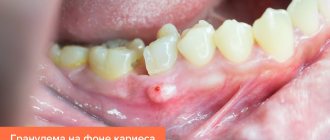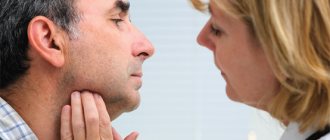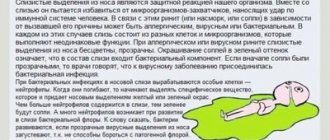Neurosis of the larynx and pharynx does not exist as a nosological unit. This is what is usually called persistent sensations: a lump in the throat, convulsions. Doctors at the Yusupov Hospital conduct a comprehensive examination of patients who complain of tension in the throat muscles and establish the cause and type of neurosis.
Global or partial changes in sensitive receptors of the mucous membranes, which cause pharyngeal neurosis, occur as a result of impaired neurotransmitter communication and infectious diseases. The most common cause of laryngeal neurosis is osteochondrosis of the cervical spine. A lump in the throat with neurosis can be felt due to the influence of the following factors:
- Inflammatory diseases of the ENT organs;
- Atrophy of cells of the laryngeal mucosa;
- Disorders of the central nervous system;
- Overwork.
Patients who have symptoms of throat neurosis are treated at the Yusupov Hospital with modern medications and methods of psychotherapy. Doctors individually select a treatment regimen. Medical staff respects the psychological problems of patients.
Types of pharyngeal neurosis
There are 3 forms of pharyngeal neurosis:
- Anesthesia;
- Hyperesthesia;
- Paresthesia.
Anesthesia of the pharynx is manifested by a decrease or absence of throat sensitivity and impaired swallowing. The disease develops in patients suffering from brain tumors, syphilis, and hysterical neurosis. The patient may aspirate food or saliva into the airway and develop aspiration pneumonia.
Pharyngeal hyperesthesia is accompanied by an increase in the pharyngeal and gag reflex. The patient has a cough and tries to cough up non-existent phlegm. This type of throat neurosis can develop after severe stress or a chronic disease of the pharynx or larynx. Patients experience a spasm, a sore throat, and a sore throat. He may feel a “scratching” sensation on the surface of the larynx.
Pharyngeal paresthesia occurs under stress. Patients feel soreness, itching and a “lump” in the throat. Women who are in menopause, impressionable and irritable people are susceptible to the disease.
Symptoms of throat neurosis in adults and children
Throat neurosis is characterized by stable symptoms that differ depending on the type of disease. The main manifestations of the disease are tissue numbness and weakening of the swallowing reflex. The disease is accompanied by severe pain throughout the body. Patients may experience increased sensitivity of the hard tissues of teeth.
Throat neurosis is manifested by the following main symptoms:
- Feeling of lack of oxygen even after taking a deep breath;
- Feeling of a lump in the throat that does not go away after drinking liquid;
- Dryness in the larynx;
- Intense thirst;
- Bronchial spasm, which is accompanied by a gag reflex and is not relieved by bronchodilators;
- Sore throat, itching, sore throat, worsening at the moment of greatest irritation;
- Pain in the neck;
- Shooting pain in the ear.
Symptoms of throat neurosis are aggravated when a person is in a dusty or smoky place. An increase in reflex reactions leads to a gag spasm during a hacking dry cough.
Symptoms of throat neurosis intensify with excitement, irritability, psycho-emotional lability, and a migraine attack. Patients' mental and physical activity decreases.
A lump in the throat with neurosis provokes the occurrence of additional symptoms:
- Mood swings;
- Disturbances in sleep and wakefulness;
- Decreased appetite;
- Hypochondria;
- Manifestations of depression;
- Fear of suffocation.
It is especially difficult to diagnose throat neurosis in children, since they are susceptible to colds, the symptoms of which are similar in symptoms to those of pharynx and larynx neurosis.
Under the influence of provoking factors, the function of the child’s immature nervous system is disrupted, which leads to the loss of neural connections between active cells of the mucous membrane of the upper respiratory tract. Children are psycho-emotionally immature. They react sharply to all irritating factors of a psychogenic nature.
For this reason, throat neurosis in children is often accompanied by somatic pathology. The child's sleep may be disturbed and emotionality may increase. Children can swallow whole pieces of food, which leads to disruption of the digestive system. Sometimes children suffering from throat neurosis develop hoarseness or aphonia (complete absence of voice while maintaining whispered speech).
Why does snot run down the back of the throat?
The pathology accompanies a number of ENT diseases. Possible reasons why snot runs down the back of the throat are:
- proliferation of adenoids;
- congenital anomalies of the structure of the mucous membrane of the posterior wall of the nasopharynx;
- deviated nasal septum;
- rhinosinusitis of various etiologies accounts for more than 50% of identified clinical cases;
- entry of a foreign body into the nasal cavity.
Women may experience the appearance of snot in the throat during pregnancy. A similar situation arises for people who work in hazardous industries or live in regions with poor ecology, or smokers. Chemical fumes, tobacco smoke, and particles of household chemicals entering the respiratory tract lead to irritation of the mucous membrane, so mucus production increases and snot flows into the throat.
The problem of leakage appears when taking certain medications. In particular, such a situation may be associated with the uncontrolled use of vasoconstrictor nasal drops. While the patient is using these medications, postnasal drip of mucus is observed. After discontinuation of the drug, mucus production normalizes and unpleasant symptoms disappear.
Some people experience snot running down their throats when the temperature and humidity change. When the microclimate is normalized, the human condition improves.
In some cases, the appearance of postnasal drip in adults and children is in no way associated with ENT diseases. The cause is pathology of the digestive organs, which is accompanied by gastroesophageal reflux. The contents of the stomach are regularly thrown into the esophagus, which causes belching, sore throat, and irritation of the mucous membrane. For this reason, mucus production increases and postnasal drip appears.
In some patients, this symptom is accompanied by endocrine pathologies leading to hormonal imbalance.
Diagnosis of throat neurosis at the Yusupov Hospital
In order to establish the cause of throat neurosis, doctors at the Yusupov Hospital conduct a comprehensive examination of the patient. Using radiography of the cervical spine, osteochondrosis is detected or excluded. More accurate information is obtained after a computed tomography scan of the spine. Patients undergo laboratory tests (general and biochemical blood tests, thyroid hormone levels).
In order to exclude the organic nature of the disease, doctors perform magnetic resonance and computed tomography of the throat. A comprehensive examination includes Doppler ultrasound of the vessels of the brain and neck, and electromyographic study. Patients are consulted by an otolaryngologist, neurologist, vertebrologist, and psychotherapist.
Treatment of snot in the throat in an adult
Postnasal drip syndrome affects people of all ages. To find out how to get rid of snot in the throat, an adult patient also needs to consult an ENT doctor. The specialist will prescribe a set of examinations to identify the cause of the pathology and appropriate treatment.
What to do if the snot in the throat does not go away after taking medications? This situation may be caused by incorrectly selected therapy or structural abnormalities of the intranasal structures and paranasal sinuses. In this case, the doctor may choose a different conservative therapy regimen or recommend surgical treatment.
Patients with a deviated nasal septum undergo septoplasty. This is an endoscopic operation that is aimed at eliminating deformation of the nasal septum without changing the shape of the external nose. Thanks to this procedure, nasal breathing is restored and one of the main causes of rhinitis and sinusitis, which provoke postnasal drip, is eliminated.
If there are indications, the patient may undergo surgery to resect concha bullosa or remove a Thornwaldt cyst, a cyst-like formation in the nasopharynx. It causes postnasal drip, which is difficult to respond to conservative therapy. After the operation, the patient's condition usually returns to normal.
Without an examination, it is impossible to say how to treat snot in the throat, so this situation requires mandatory attention from specialists.
Treatment of throat neurosis
Symptoms of neurosis of the pharynx and larynx disrupt the quality of life of patients. At the initial stage of the disease, it is performed on an outpatient basis. The patient is recommended to change his lifestyle, maintain the correct daily routine, alternate between wakefulness and sleep, go to bed on time, and get a good night's sleep. If the cause of neurosis is sleep, the symptoms of the disease disappear after several days of rest.
In the presence of an inflammatory process, anti-inflammatory therapy is carried out. A patient with throat neurosis is prescribed herbal sedatives. The selection of medications and dosage is carried out by a doctor. After several days of taking medications, the symptoms of neurosis of the pharynx and larynx disappear. If the patient feels a lump in the throat during neurosis, pureed liquid food is prepared for him, which does not irritate the mucous membrane of the pharynx. You should stop smoking, drinking alcohol, and eating spicy foods.
If the therapy is ineffective, doctors prescribe small doses of antidepressants in the presence of depression and asthenic syndrome. To treat throat neurosis, which manifests itself as hypochondria (constant worry about the possibility of contracting a serious illness), antipsychotics are used. If the cause of throat neurosis is a disease of the cervical spine, neurologists at the Yusupov Hospital treat it using medications, physiotherapeutic procedures and modern rehabilitation methods. In some cases, manual therapy is performed.
Psychotherapeutic techniques include hypnotherapy and cognitive behavioral therapy. Psychological correction techniques are aimed at teaching the patient effective ways to relax. Treatment has the following goals:
- Leading the patient to understand the true causes of the pathology;
- Identification of psychotraumatic factors;
- Eliminating them or learning to adapt to them.
Children suffering from neurosis of the throat and larynx are observed by several specialists: an otolaryngologist, a psychologist, a speech therapist (depending on age). Correct parental behavior increases the effectiveness of treatment. Most of the psychogenic factors that cause neuroses in children come from home.
Children with throat neurosis undergo restorative therapy, which includes vitamin complexes and mild sedatives. During the treatment of throat neurosis in a child, it is important to suppress obvious physical symptoms. When there is a sore throat, children are prescribed rinses, inhalations, absorbable tablets, and medications that increase the level of immunity. For infectious diseases, dekasan or trachysan are prescribed.
Psychotherapy for children involves classes on general development, training in relaxation techniques, which include breathing exercises. Babies receive a full body massage aimed at finding blocks and relaxing them. Psychotherapists recommend that parents change the psychogenic situation at home, reconsider their behavioral reactions and correct them. It is important that the child follows a daily routine. He needs to introduce healthy foods into his diet, enriched with vitamins and minerals.
A child with neurosis of the pharynx and larynx should be treated carefully. There is no need to scold him, but hysterics must be stopped immediately. With neurosis, a spasm of the throat is often observed. During an attack, it is necessary to help the child cope with the situation, calm him down, and explain how to breathe correctly.
Treatment of snot in the throat of a child
If postnasal drip occurs in a child, a consultation with an ENT doctor is required. The specialist assesses the condition of the upper respiratory tract, collects information about recent diseases, congenital or acquired anomalies of the upper respiratory system. Hardware diagnostic procedures include: rhinoscopy, mesopharyngoscopy, radiography or CT. This allows you to identify the cause that triggered the flow of mucus into the throat and determine how to treat postnasal drip. When identifying an inflammatory process, it is important to determine its cause. A general blood test helps with this. In bacterial infections, leukocytosis with increased ESR is observed. Viral infections lead to neutropenia and lymphocytosis. Allergic reactions are promoted by eosinophilia.
In most cases, the pathology can be eliminated with conservative therapy. If the cause is rhinitis or sinusitis, it is important to determine the nature of the rhinitis. For bacterial infections, antibiotics are indicated. If the inflammatory process is caused by a virus or allergen, symptomatic treatment is used. If snot runs down the back of the throat, antihistamines and corticosteroids may also be used for treatment. They help relieve swelling of the mucous membrane and thereby relieve symptoms.
For severe coughs, antitussive drugs are prescribed: expectorants and other drugs.
Relieving throat muscle tension during neurosis
Tension of the throat muscles during neurosis causes breathing problems. In the complex treatment of neurosis of the pharynx and larynx, breathing exercises can give good results. It helps relieve spasm and tension in the respiratory muscles, restore breathing rhythm, reduce the dosage of medications, and speed up the healing process. You need to take an active short breath and a natural passive exhalation. The air should be inhaled through the nose, making a short, strong movement, and exhaled through the mouth.
The breathing movement and inhalation must coincide in time. The rhythm of breathing movements should correspond to the rhythm of the march. Breathing exercises for throat neurosis can be done standing, sitting or lying down. Their effectiveness improves in fresh air. To determine the cause and type of throat neurosis, exclude the organic nature of the disease and undergo a course of effective therapy, call the contact center of the Yusupov Hospital.









